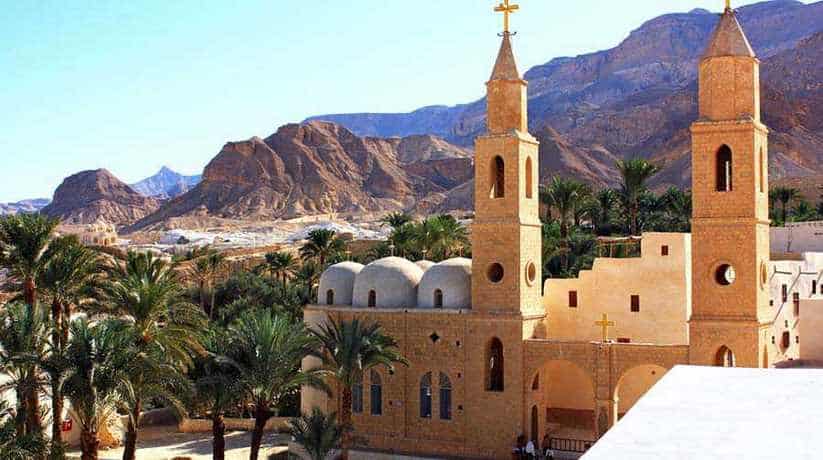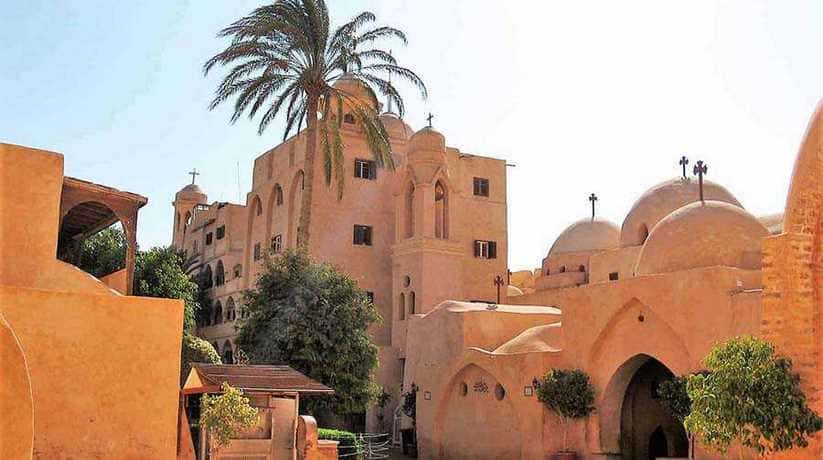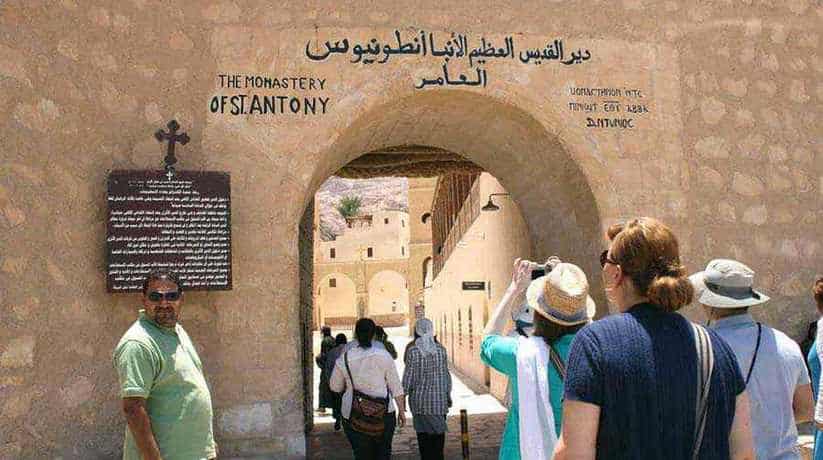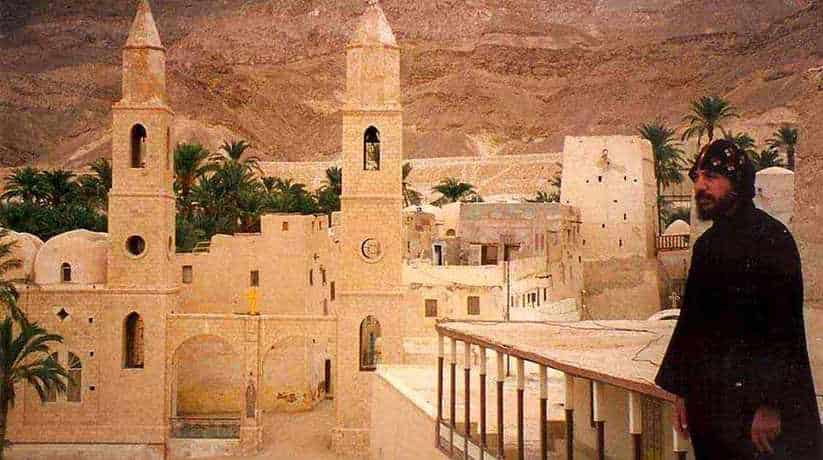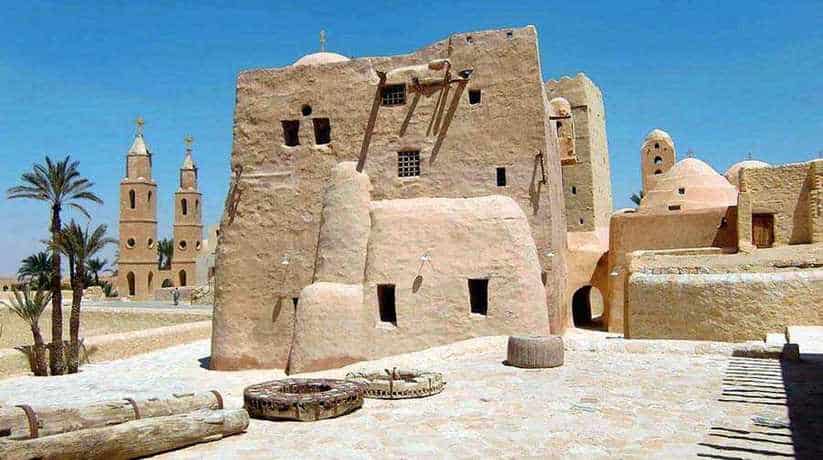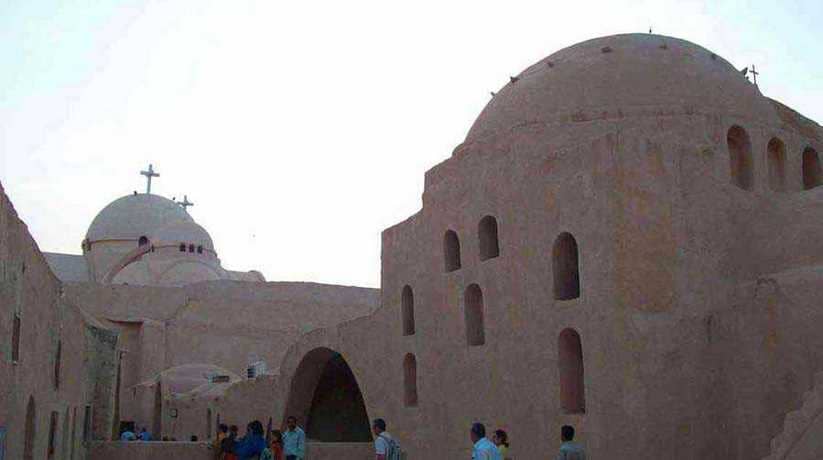St Anthony monastery and St Paul Monastery information, tours
St Anthony Monastery and St Paul monastery located in fact near to Hurghada city. Born in the Upper Egypt town of Coma near Heracleopolis in the year 251 A.D, St. Anthony the Great. When orphaned at the age of 18, became a hermit and thus lived to 105 years old. In fact, he lived as an Anchorite, as still exists in Egypt, and he tormented his entire life by flatteries and temptations of the devil. He, along with St. Pachomius, were two of the first exponents of Christian monasticism, which originated in the Egyptian desert. Moreover, he buried beneath one of the ancient Churches of the St Anthony monastery. A book written by Athanasius, the bishop of Alexandria, thousands across Europe to follow in the hermit’s footsteps.
In fact, St Anthony Monastery and its neighbor St Paul Monastery, are both Coptic Christian. Moreover, they are the oldest inhabited monasteries in Egypt. Furthermore, they hidden deep in the Red Sea Mountains and relying on springs for their water supply. In fact, both still observe rituals that hardly changed in 16 centuries. They are accessible by special tours from Cairo, Suez or Hurghada. In fact, a stay in either monastery can arranged in advance.
More information about St Anthony monastery and St Paul Monastery:
St Anthony Monastery lies at the foot of Al-Qalzam Mountain near Al Zaafarana. In fact, it founded in 356 AD just after the saints death. Moreover, it is indeed the oldest active monastery in the world. In fact, St. Anthony founded several Monasteries during his life. Though they would not have been recognizable in the modern use of the term, but alas they are no more. We know little of the monastery’s very early period. However, during the sixth and seventh centuries many monks from Wadi El Natrun were under frequent attacks. It was by Bedouins migrated to St. Anthony’s. But this monastery plundered on many occasions also, being partly destroyed in the 11th century.
Between the 12th and 15th centuries, the monastery flourished but plundered again in 1454 by Bedouin servants. Due to such attacks, this is a fortress style monastery. Though Coptic today, over its many years the monastery was often multi-faith, housing monks of several different Christian religions. Today it is a self-contained village with gardens, a mill and a bakery. Moreover, the monastery houses five Churches, the best of which is St. Anthony’s Church. Egypt Monasteries are experiencing a revival, and the monk population of St. Anthony’s grown considerably in recent years. In fact, the Monastery has exceptional wall paintings of holy knights in bright colors. Moreover the hermit founders of the monastery are in subdued colors and icons.
Further information about St Anthony monastery and St Paul Monastery:
In fact, these wall paintings, widely known to monks and art historians. Moreover, they also obscured by soot, candle grease, oil and dust. But recently, these unique painting restored. In fact, it was in a collaborated effort between the Supreme Council of Antiquities and the American Research Center in Egypt. One set of the paintings attributed to a team lead by a Coptic master named Theodore. Moreover, the other appears to be done by team with Byzantine influence. The oldest paintings date back to the seventh and eighth centuries, while the newest are from the thirteenth century. In addition to the paintings, woodwork inside St. Anthony’s Church also restored.
St Anthony monastery also housed a library with over 1,700 handwritten manuscripts. Unfortunately, the Bedouin servants who plundered the monastery used many manuscripts for cooking fuel. At one time, there must have been a much more extensive library. St. Anthony’s Cave (magharah), where he lived as a hermit, is a 2 km hike from the monastery. Moreover, it is 680 meter above the Red Sea. It offers stunning views of the mountains and the sea and the chance to see a wide range of bird life.
St Paul Monastery:
Egypt’s Eastern Desert, at least for now, provides us little in the way of antiquities for travelers. Pharaonically, there are a few trade routes and other ruins. However, it is the home to two of Egypt’s best known Christian monuments which include the well known monastery of St. Anthony. Perhaps the less well known St Paul Monastery of Thebes. In fact, St Paul Monastery probably dates to the fifth century. Moreover, it founded in memory of one of Egypt’s greatest saints and anchorites. In fact, he lived in a cave over which it built for a period of some eighty years. We mostly know of his life from the writings of St. Jerome and his work, Vita Pauli (Life of Paul), which written between 375 and 380 AD.
St. Jerome tell us that, while it may have been St. Anthony who founded the monastic way of life by inspiring others, Amathas and Macarius, who were disciples of Anthony, affirm that Paul of Thebes was actually the originator of the practice. St. Paul apparently born to rich parents in the year 228. However, by the age of sixteen, he lost his parents. This would correspond with the terrible period of Christian persecution perpetuated by Decius and Valerian. It was in fact between 249 and 260 AD. After the death of his parents, Paul renounced his inheritance and consecrated his life to God. Eventually seeking refuge in the wilderness of Egypt’s Eastern Desert, where he lived until the age of one hundred and thirteen.
More information about St Paul Monastery:
Living in his cave, and clothed in a tunic made of plaited palm leaves, tradition holds that a raven brought a half of a loaf of bread which day for him to eat. Jerome tells us that Anthony, who apparently at least a contemporary of Paul, told of someone living in the desert that was holier then he. Hence, he set out to find Paul and, having succeeded, had a friendly conversation with him. That evening when the Raven came to bring the saint’s nourishment, he came with a whole loaf so that both the holy men might have substance.
Apparently, Anthony and Paul continued to be friends for many years. When Paul thought that he approaches death, he asked Anthony to fetch the cloak which the patriarch Athanasius given him. However, when Anthony arrived at the cave where Paul lived those many years, he saw angels carrying the soul of the holy ascetic to heaven. In fact, Paul’s body remained in the cave. But two lions approached and dug a grave into which Anthony placed Paul’s body wrapped in the cloak he had fetched. Anthony kept Paul’s tunic of palm leaves, which he wore to celebrate the occasions of Easter and Pentecost.
Further information about St Paul Monastery:
St Paul monastery also called the Monastery of the Tigers. It was perhaps because of its wilderness location, always associated with the Monastery of St. Anthony, usually in a subordinate manner. The first travel narrative we have of the monastery provided by Antoninus Martyr, a native of Placentia who visited the tomb of St. Paul between the years 560 and 570 AD. The first monks to occupy the monastery may have been Melchite. In fact, they followed by Egyptian and Syrian monks. The Syrians may had a sustained existence at the monastery. It appears that they also occupied the monastery during the first half of the fifteenth century, after which their presence disappears.
According to an isolated Ethiopian reference, the seventieth patriarch of the Coptic Church, Gabriel II (1131-45 AD) banished to the monastery for three years. Like many of Egypt’s earliest Monasteries, this one suffered at the hands of Bedouin tribes. One during the year 1484 was particularly destructive, when many of the monks were killed and their library put to the torch. Afterwards, the monastery rebuilt under the patronage of Patriarch Gabriel VII. In fact, he sent ten monks from the Monastery of the Syrians (Wadi El Natrun). Yet, during the second half of the sixteenth century, it was again attacked. Moreover, it ransacked twice, forcing the monks to finally leave.
The monastery apparently set deserted for the next 119 years, only to be repopulated by a group of monks from the Monastery of St. Anthony under the patronage of John XVI, who promoted an extensive reconstruction in 1701.
The Walls:
Most ancient, remote Egyptian Monasteries are in fact fortifications for good reason. Likewise, St. Paul’s Monastery has high defensive walls surrounding the monastic buildings. The history of this enclosure is complex and corresponds to various periods. We know that the walls considerably enlarged during the eighteenth century under John XVI, but the final walls we see today were completed during the nineteenth century. Also like many other Monasteries, the fortress appears to have had no original door and therefore we find on the inside of the east wall the ancient hoist used to haul food, goods and even visitors up the wall and into the monastery.
The Tower:
The tower (keep, or qasr) is perhaps one of the most obvious structures within the complex. As usual, it was entered via a drawbridge and represented the last defensive bastion against the desert raiders. Situated next to the church of St. Paul, in the past, its ground floor served as a cemetery for the monks, while the second floor was a storeroom for the food reserves which would sustain the monks through a period of long siege. Traditionally in Coptic Monasteries, the highest story is dedicated to the archangel Michael, but since he is already the titular saint of the large church in the center of the monastery, here the third floor has a chapel dedicated to the Holy Virgin, which is roofed with a wooden cupola. There are also cells for the monks on this level of the tower.
Churches:
Altogether, the Monastery of St. Paul has four Churches, three of which situated in the ancient part of the complex.
The Church of St. Paul:
Attesting to its antiquity, the Church of St. Paul , also sometimes referred to as the Cave Church, located next to the tower sits three meters below the current level of the monastery grounds. This is the spiritual center of the monastery. Its southern end is the oldest part, hollowed out of the cave in which St. Paul believed to have lived. This section of the church, at least, probably dates to the fifth century. The north part of the church dates to medieval times. One enters this church via a staircase attached to the the chapel walls. Within, the church proper consists of one nave in the center and three sanctuaries dedicated to the twenty four elders of Revelation (north, St. Anthony (center), and St. Paul (south).
The central and south sanctuaries and the part of the nave facing them were excavated from the rock itself, while the remainder of the building to the north is made of masonry. The wooden cupola which roofs the chapel is decorated with the equestrian figures of Saints Apater and his sister Irene, Isidore, Apa Iskhirun, James and Julius, all warrior saints. These were produced by the monastery monks in 1713, but probably overlay earlier iconography that is lost to us. The paintings on the walls of the cave date to the same restoration work, portraying biblical subjects such as the archangels Michael, Gabriel, and Raphael, as well as the angel and Aniel’s three companions, Hananiah, Mishael and Azariah, respectively called Shadrach, Meshach and Abednego by the officer of King Nebuchadnezzar (Dan 3:10-26).
More information about the church of St. Paul:
However, in the middle sanctuary dedicated to St. Anthony, though in poor condition, are wall paintings. In fact, they date back to the first half of the fourteenth century. Here, we can just make out depictions of Christ enthroned, the annunciation, St. John the Baptist, angles and archangels. In fact, the body of St. Paul kept in a marble shrine on the south side of the nave. One traditional story holds that the saint’s relics taken to Constantinople in 1240. From there they sent to Venice in 1381.
Indeed, an urn in the church of St. Julian in Venice believed to contain some of his remains. Recent analysis shown that the remains in Venice are that of only a leg of a very old man (over eighty). In fact, he lived between the first century and the first half of the forth centuries, AD. Hence, they certainly may be a fraction of the body of the saint that mostly rests in the Egyptian monastery that bears his name.
The Church of St. Mercurius:
Located above Paul’s cave, and almost atop the Church of St. Paul, the church of St. Mercurius (Abu al-Seifein) dates from the end of the eighteenth century. Hence, it contains few interesting elements, with the exception of a precious iconostasis inlaid with ivory and mother-of-pearl. This church connected to the cave by a much older staircase. Many Churches in Egypt are dedicated to this saint, the most well known of which is probably in Old Cairo. This church only used once a year during the week prior to Lent.
The Church of St. Michael:
The Church of St. Michael (al-Malak) was in 1777, with a roof consisting of twelve cupolas. It has two sanctuaries including one dedicated to St. Michael to the north, and to St. John the Baptist in the south. While the true spiritual center of the monastery is the subterranean church of St. Paul, it is two small for the daily liturgy, so this service held in the the Church of St. Michael, which is the largest church in the complex.
The Refectory and the Mill:
Within the monastery is an ancient refectory that is no longer in use, but which dates back to medieval times. It situated in the east wing of the complex. The main axis of the refectory covered by a barrel vaulted roof. Within, a heavy masonry table with a lectern fashioned on its west end, from which the sacred texts and the lives of the saints and martyrs read during the community meal, dominates the room. The refectory entered by way of a narrow passage, and on the west side of the passage are two rooms. In fact, they once used as mills. Within are big stone millstones which operated by huge wooden gears turned by draft animals.
The Spring of St. Paul:
An ancient spring named for St. Paul resides in the north wing of the complex. In fact, it continues to supply water at the rate of about four cubic meters per day. The water comes from a mountain crevice and flows into a cemented reservoir tank. In fact, it used for drinking and cooking. A small drain allows the surplus water into a second reservoir. It used by the monks for washing, and a final drain carries off the remaining water into a large basin where it distributed for irrigation. However, a second spring, known as the Pool of Miriam located about one hundred meters to the south of the monastery. In fact, it named after the sister of Moses and Aaron, who according to tradition washed there during the Exodus.

